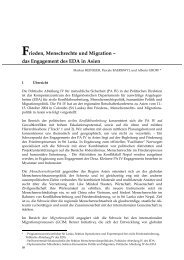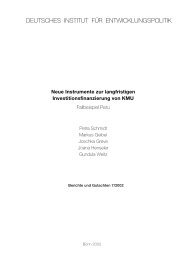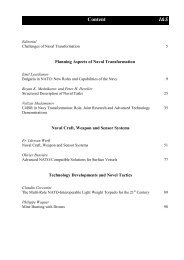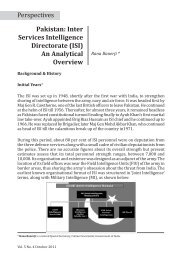Andreas Stamm Eva Dantas Doris Fischer Sunayana ... - ETH Zürich
Andreas Stamm Eva Dantas Doris Fischer Sunayana ... - ETH Zürich
Andreas Stamm Eva Dantas Doris Fischer Sunayana ... - ETH Zürich
Create successful ePaper yourself
Turn your PDF publications into a flip-book with our unique Google optimized e-Paper software.
<strong>Andreas</strong> <strong>Stamm</strong> et al.<br />
ages among them as well as gaps and missing links that lower technological capabilities. 12<br />
The majority of the early studies following the NIS approach remained relatively descriptive.<br />
In 1994, Nelson outlined the concept of “co-evolution of technology, industrial structure,<br />
and supporting institutions”, stressing the cumulative character of technological<br />
learning and the possible path dependency of technological trajectories. This may be seen<br />
as an important step towards a common understanding of NIS evolution.<br />
In a parallel scholarly development, regional economists and economic geographers<br />
stressed the empirical fact that in many cases specific innovative capabilities arise not at<br />
the nation-state level but within geographically limited spaces. They analysed and highlighted<br />
the importance of specific and often locally or regionally bound resources and of<br />
complementarities among private and public actors within clusters, such as Silicon Valley<br />
or “Third Italy”. Especially with regard to high-tech regions in developed countries, the<br />
focus was on the important role of actors sharing common social and cultural values<br />
(“creative milieus”) (Fromhold-Eisebith 1999), to some extent reviving the much older<br />
concept of industrial districts. 13 This line of research led to the concept of regional innovation<br />
systems (RIS). Even though the term was coined already at the beginning of the<br />
1990s (Cooke 1992), the concept became really popular only at the beginning of the new<br />
millennium (Doloreux / Parto 2005).<br />
Finally, in recent years the sectoral innovation system concept has started to gain importance.<br />
This reflects the growing awareness that, in many cases, technological capabilities<br />
and innovation potential have to be analysed at the level of distinct sectors in order to<br />
achieve a thorough understanding of them. Especially in high-technology sectors, such as<br />
pharmaceuticals or information and communication technology (ICT), innovative dynamics<br />
have to be conceptualised as the outcome of complex interaction between local/regional,<br />
national and international actors (Malerba 2004). Sectoral systems of innovation<br />
have a lot of variability since they emerge and develop in continuously changing environments,<br />
are characterised by path-dependent processes and are embedded in different<br />
socio-economic contexts (Kristinsson / Rao 2007, 6).<br />
With very few exceptions, IS research focuses on the developed market economies. The<br />
book edited by Lundvall, while basically issue-centred, refers exclusively to concrete cases<br />
bearing on historical or recent experiences of Europe, the US and Japan. The selection of<br />
NIS studies edited by Nelson, as well as the compendium edited by Malerba on sectoral<br />
innovation systems, also comprise mainly EU countries (Germany, UK, France Italy), the<br />
US, Canada, Japan. Argentina, Brazil, Israel, Korea and Taiwan are included as examples<br />
for less advanced countries. Only recently have a number of other countries been included in<br />
this strand of the research, e.g. Uruguay (Arocena / Sutz 2000), some African countries<br />
(Muchie / Gammeltoft / Lundvall 2003) or India, Indonesia and Thailand in the book on<br />
Asia’s Innovation System edited by Lundvall / Patarapong / Vang (2006). The attention of<br />
an increasing number of researchers is drawn to China, triggered by the high dynamics of its<br />
development (Guangzhou 2007; Altenburg / Schmitz / <strong>Stamm</strong> 2008). In Section 5.2 we will<br />
outline some basic assumptions on what may make IS formation different in countries that<br />
today are striving to catch up technologically with the OECD world.<br />
12 Actually, South Africa, in a White Paper on R&D from 1996, has adopted the innovation system approach<br />
as the concept for policy making in this field, one of the first countries worldwide to do so.<br />
13 This term was coined by the British economist Alfred Marshall (1842−1924).<br />
24<br />
German Development Institute / Deutsches Institut für Entwicklungspolitik (DIE)
















